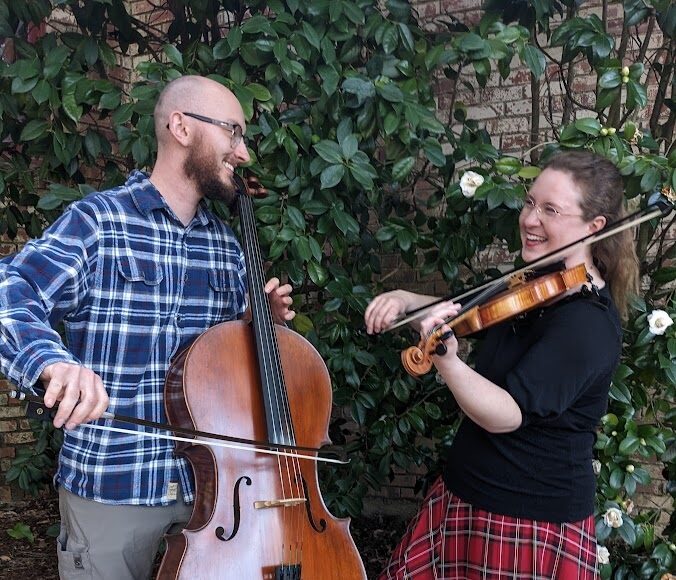May 20 is World Fiddle Day, and yet, to mark the occasion, we’ve spoken with a cellist. Thomas Dewey is a Santa Cruz-based musician who began playing cello as a nine-year-old. He jokes that he chose it “out of spite.”
“My parents wanted me to start learning a stringed instrument,” he says. “And the options I knew of were violin, viola, or cello. I didn’t know about the bass, so I picked the biggest one of those three. I was like, ‘Well, if you’re gonna make me play, I’m going to play the biggest one.’”
Dewey—who is set to perform in the orchestra for Cabrillo Stage’s The Hunchback of Notre Dame—has been playing classical cello ever since. He always enjoyed Celtic music but didn’t think the cello had a place in it. His perspective changed after listening to an album by renowned traditional Scottish fiddle player Alasdair Fraser and cellist Natalie Haas while in college.
“I had no idea that the cello could be so powerful. And then I heard Natalie play. The minute I heard that, I was like, ‘How do I do that? I want to do that.’ That made me realize that it was possible to have a place in Celtic music as a cellist.”
Dewey plays with the San Francisco Scottish Fiddlers, which, despite its name, is made of more than fiddlers.
“The club was founded by people who play violin. It grew out of that, but eventually, other instruments that could and wanted to participate in traditional Celtic and other traditional music joined. It’s mostly fiddles, but we have cellos, guitars, sometimes basses, sometimes flutes, percussion.”
It is worth noting here that the violin and the fiddle are the same instruments, played in different styles, with the violin more often referenced in conjunction with classical music and the fiddle referring to its use in traditional music. The San Francisco Scottish Fiddlers play across traditions.
“There’s a focus on Scottish music, but we play everything from now to the Celtic diaspora. And the Celtic-adjacent world, like, Scandinavian music and music of Brittany, France and some stuff from Spain. It’s quite far-reaching.”
Dewey mentions two places in Santa Cruz where people meet up and play Irish and Scottish tunes—the Steel Bonnet Brewery in Scotts Valley and Rosie McCann’s downtown (more Irish-focused.)
Dewey smiles when asked about the difference between Scottish and Irish traditional music.
“Some people say the difference between Scottish and Irish music is sixteen kilometers. And I mean, there’s a lot of crossover. They have some distinct idiosyncrasies. I can’t speak so much for Irish music, but Alasdair [Fraser] likes to say [Scottish traditional music] has its distinct accent. All music does, but there are certain ornaments and specifically tune types. For instance, the Strathspey is a style of tune unique to Scotland, and it’s not found in Irish music to my knowledge.”
Alasdair Fraser also likes to say things like: “Liberate your bow” and “Find the haggis.”
“I think he’s speaking to people like me, who grew up playing classical music,” Dewey explains. “Classical music is very prescriptive. It’s sort of straight and narrow and formal. You play within the lines and play what’s on the page and nothing else. Whereas traditional music, it’s a lot more organic. It’s raw. You want to tap into that feeling through your bow.”
As for Fraser’s reference to the haggis—a traditional food from Scotland made from boiling the organ meats of sheep with a mixture of grains and spices—it’s all about digging deep.
“You have to dig deep into that Scottish energy,” Fraser says. “But he doesn’t just mean Scottish music. When he says that, he uses it as a metaphor for finding that heart of live music.”
Fraser will direct the San Francisco Scottish Fiddlers in their upcoming performances in Carmel, Berkeley and Palo Alto. He will also head up the 40th Valley of the Moon Scottish Fiddle Camp at Camp Campbell in Boulder Creek.
Gatherings like the Valley of the Moon Scottish Fiddle Camp are essential to passing on knowledge surrounding these traditional music forms.
“[These camps] keep playing this music alive and relevant. It’s where a lot of knowledge is shared. Everybody brings their favorite tunes or what they’re playing, and you can learn. You’re not just learning from the faculty but from your peers. You’re learning from the community. You’re learning what’s popular now, and you pick up all sorts of things, even outside of class. You learn about new artists and new ideas and ways of doing things.”
With the uptick of contemporary collaboration, the cello’s popularity is growing. This tune, which Dewey and Caroline McCaskey picked up at the Valley of the Moon, features Dewey on cello and McCaskey on fiddle.
“My understanding is that the fiddle and cello pairing goes way back to the 17th and 18th centuries when it was the classic pairing for dance bands. And then it fell out of favor. Only more recently has it come back into the instrumentation. It’s less common than a lot of things. But it’s coming back.”












